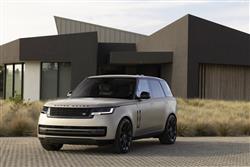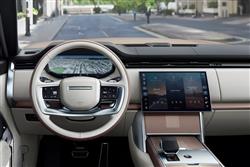Land Rover Range Rover P460e - ABC Leasing
How will you view?
This is a sample, showing 30 seconds of each section.
HOME ON THE RANGE(some text hidden)
By Jonathan Crouch
Ten Second Review word count: 49
The Range Rover's been many things since we first saw it in 1970 but this P460e variant is the best all-round Plug-in Hybrid version we've yet seen. There's a six-figure sum for ownership, but with up to 75 miles of EV range, that's now a little easier to justify.
Background word count: 143
We've had Plug-in Hybrid Range Rovers since 2018. The problem is that the early ones weren't very good. Land Rover claimed you could go 31 miles on battery power with the first L405-series model - though that wasn't much to write home about and it was actually way less in the real world. But slowly, JLR's PHEV tech has got better. Just how much better, we going to find out with our review of this L460-series Plug-in Hybrid Range Rover, launched in 2022. This is the fifth generation Range Rover model, a car designed around the need for the option of a full-EV drivetrain. So you'd hope it would have space for a bigger PHEV battery - which was indeed what this model (originally badged 'P440e') got at its introduction, providing for a far better all-round end-user package. Let's take a closer look.
Driving Experience word count: 196
This 460PS P460e model is the more accessible of the two Range Rover Plug-in hybrid options. Both use the brand's usual 3.0-litre petrol turbo unit paired with a 38.2kWh battery offering an impressive all-electric range of up to 75 miles. Drive less sedately and 62mph is 5.5s away en route to 140mph. If you can stretch to top 'Autobiography' trim, you can get the same powertrain with more speed with the faster P550e version (total output 550PS). This improves the performance figures to 5.0s for the 0-62mph sprint and top speed rises to 150mph. Both the engines available are paired with an 8-speed auto gearbox with 4WD, low range capability and the brand's usual 'Terrain Response 2' tech offering different drive modes for challenging surfaces. Despite its electrification, the car can drive through water as deep as 900mm and the 295mm ground clearance can be raised further 145mm in the highest air suspension setting. On tarmac, a 48V anti-roll system counters cornering body roll. And standard four-wheel steering turns the rear wheels by up to 7-degrees in the opposite direction to the fronts at low speeds, reducing the turning circle to a family hatch-like 10.95 metres.
Pictures (High res disabled)

.jpg)
.jpg)
.jpg)
.jpg)
.jpg)
.jpg)
.jpg)

Scoring
Category: Compact Car
| Performance | |
| Handling | |
| Comfort | |
| Space | |
| Styling | |
| Build | |
| Value | |
| Equipment | |
| Economy | 70% |
| Depreciation | 70% |
| Insurance | 50% |
| Total | 68% |

